Top 7 AI Features for Smart Irrigation Systems
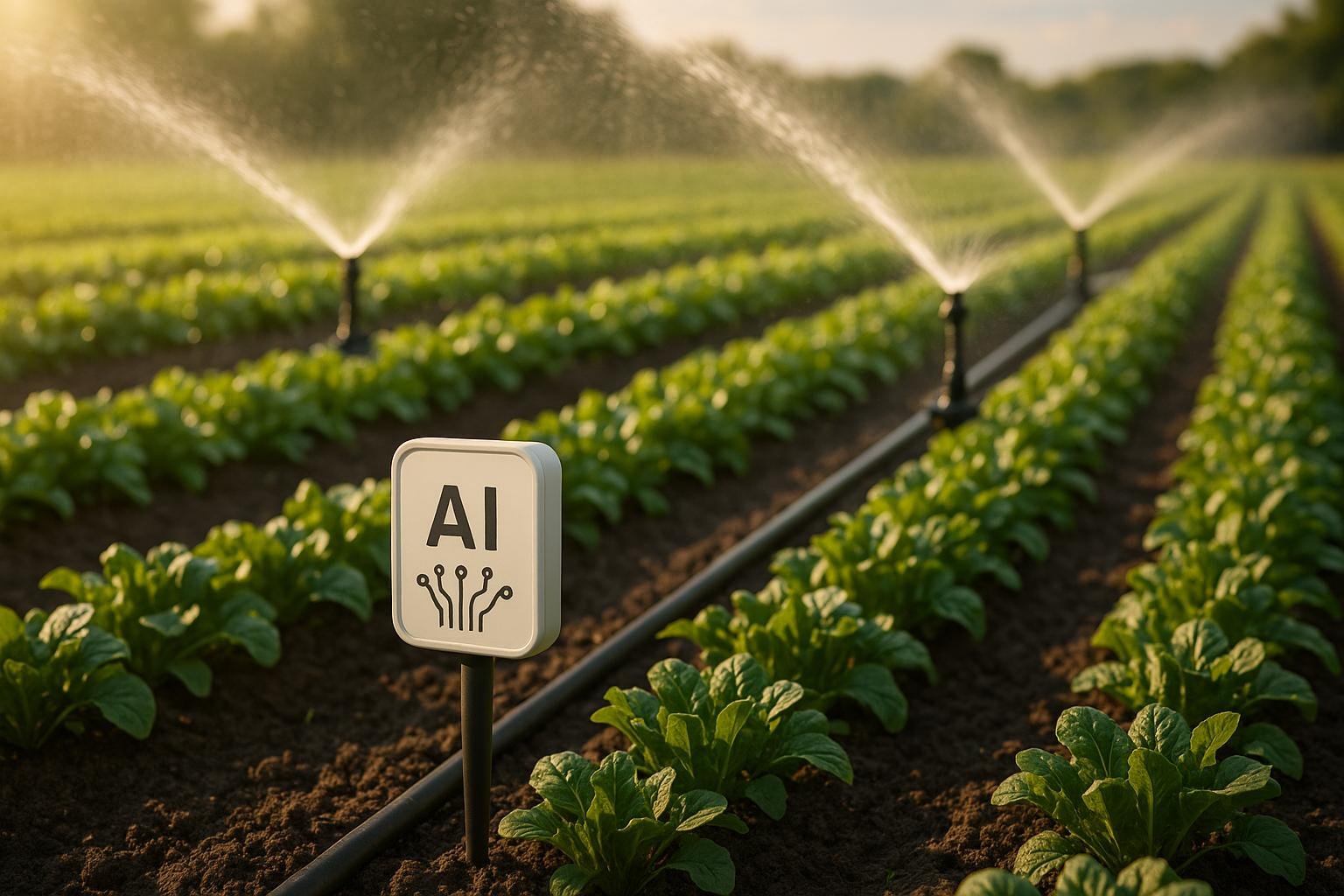
AI-powered irrigation systems are reshaping water management, saving up to 50% of water while boosting plant health and crop yields by 20–30%. These systems use real-time data, weather forecasts, and advanced algorithms to optimize water usage, prevent waste, and improve efficiency. Here's a quick rundown of the top features:
- Soil Moisture Sensing: Monitors soil conditions and waters only when necessary, reducing water use by up to 90%.
- Weather-Based Algorithms: Adjust watering schedules based on weather data, cutting water waste by 30%.
- Plant-Specific Settings: Customizes irrigation for different plants and locations, reducing stress and improving growth.
- Leak Detection: Identifies and fixes leaks to prevent water loss and property damage.
- Drone Mapping: Provides aerial insights on water stress and plant health for precise irrigation.
- Frost Protection: Automatically prevents frost damage using real-time weather data.
- Energy-Efficient Pumps: Lowers energy use by aligning water delivery with demand.
These features not only conserve resources but also reduce utility bills and maintenance costs. Whether you're managing a home garden or a large landscape, these systems simplify irrigation while delivering measurable benefits.
AI Powered Automated Irrigation Systems | Smart Farming Solutions

1. Real-Time Soil Moisture Sensing and AI Water Scheduling
Real-time soil moisture sensing paired with AI-driven water scheduling is at the heart of modern smart irrigation. These systems rely on sensors that continuously monitor soil moisture at the root zone and activate irrigation only when it's truly needed.
Here’s how it works: the sensors measure the actual water content in the soil at the plant's root level. If moisture levels drop below a set threshold, the AI system kicks in and waters the area. On the flip side, if the soil has enough moisture, the system skips the scheduled watering altogether. This targeted approach not only saves water but also promotes healthier landscapes.
Water Conservation Efficiency
The potential for water savings with these systems is impressive. Research shows that soil moisture sensors can reduce water usage by anywhere from 38% to 90% over multiple years [7][6]. The secret lies in their precision: instead of watering on a fixed schedule, the AI uses real-time data to irrigate only when the soil approaches its lower moisture limit. This ensures plants stay hydrated without wasting water [5].
Impact on Plant Health
AI water scheduling also plays a big role in supporting plant health. By using data from sensors and weather forecasts, these systems prevent both overwatering and underwatering. In fact, precision farming powered by AI has been shown to boost crop yields by 20% to 30% [1].
The system adapts to the specific needs of plants, taking into account their growth stages and seasonal changes. For instance, young plants with shallow roots get lighter, more frequent watering, while mature plants receive deeper, less frequent irrigation. This tailored approach reduces stress on plants and encourages robust growth [1].
Automation and Ease of Integration
Modern soil moisture sensors are designed to integrate easily with existing irrigation setups. If you already have an irrigation system, you can upgrade it cost-effectively by adding sensors instead of replacing the whole system [9]. These sensors come in both wired and wireless options, with wireless models offering extra flexibility for retrofitting. Pairing them with Wi-Fi–enabled smart controllers gives you real-time updates and remote control through smartphone apps [10].
Installing the sensors involves placing them at various depths and locations within irrigation zones. The system then tracks soil moisture trends daily or weekly, learning how the soil responds to weather and watering [5]. Over time, it adjusts its performance to optimize efficiency. Advanced systems even include soil freeze sensors, which stop irrigation when temperatures dip below 32°F, protecting both plants and equipment year-round [9]. This seamless integration not only enhances efficiency but also leads to long-term savings.
Financial Benefits for U.S. Homeowners and Landscapers
The financial perks of these systems are hard to ignore. On average, homeowners see a 200% return on investment within the first year, thanks to lower water bills and healthier plants [7]. The cost of soil moisture sensors ranges from $99 to $165, while smart controllers can cost between $280 and $1,800, depending on their features [9]. Adding sensors is often more affordable than replacing an entire irrigation controller, especially if your current system is compatible [9].
These systems save money by significantly reducing water use. On average, they cut irrigation needs by 72% compared to traditional schedules [9], potentially saving homeowners hundreds of dollars each year. Plus, many water providers in the U.S. offer rebates for installing water-efficient systems, so it's worth checking for local incentives [12]. Beyond water savings, these systems help avoid costs associated with replacing stressed or damaged plants, ensuring a thriving and attractive landscape [11].
2. Weather-Based Irrigation Algorithms
Weather-based irrigation algorithms represent a leap forward in smart irrigation technology. These systems rely on intelligent controllers and sensors to monitor weather conditions and adjust watering schedules automatically, based on evapotranspiration rates [13]. Rather than sticking to rigid schedules, they calculate how much water plants lose through evaporation and transpiration, then replenish only what's truly needed.
The system works by tracking key weather factors like temperature, humidity, wind speed, and solar radiation. Using this data, it calculates daily evapotranspiration rates and adjusts the watering schedule to replace only the water that was lost. It even accounts for historical weather trends, yesterday’s conditions, and tomorrow’s forecast to fine-tune irrigation [13]. In essence, it transforms weather data into precise, actionable irrigation adjustments.
"Adjusting irrigation runtimes daily, based on real-time water requirements, is the most effective way to irrigate for optimal plant health and water savings." - Rain Bird [13]
Weather-based irrigation controllers (WBICs) tailor watering schedules using local weather data and landscape conditions. They fall into three categories: signal-based systems that receive weather data from external sources, historic evapotranspiration (ET) controllers that rely on stored weather patterns, and on-site weather measurement controllers that gather real-time local data [9].
Water Conservation Efficiency
The potential for water savings with these algorithms is substantial. Self-adjusting technology can reduce water use by up to 30% compared to traditional irrigation methods [13]. For an average home, swapping a standard clock-based controller for a WaterSense-labeled weather-based irrigation controller can save nearly 7,600 gallons of water annually [14].
On a national scale, the impact is staggering. If every U.S. home with an automatic sprinkler system installed a WaterSense-labeled controller and used it correctly, the country could save $2.5 billion in water costs and 220 billion gallons of water annually [14]. This is particularly meaningful given that over 28 million U.S. homes have in-ground sprinkler systems, most of which rely on outdated clock-based controllers that don’t adjust for seasonal changes [14].
Real-world data backs up these claims. In Las Vegas, Nevada, homes equipped with evapotranspiration-based controllers reduced irrigation water use by an average of 20% compared to those using homeowner-set schedules [9]. Another study on St. Augustine turfgrass found that ET-based controllers cut irrigation by 43% during summer months while maintaining turf quality [9].
Impact on Plant Health
These systems don’t just save water - they also improve plant health. By using evapotranspiration data, which accounts for both soil evaporation and plant transpiration, the algorithms ensure plants get the right amount of water at the right time [9].
Changing weather patterns can disrupt plants' natural bloom cycles, altering their flowering seasons and durations [15]. Weather-based systems adapt to these shifts by continuously monitoring environmental conditions and adjusting watering accordingly. This flexibility helps plants thrive, even as weather becomes less predictable.
The precision of these systems minimizes stress caused by overwatering or underwatering. In fact, integrating AI into irrigation systems has reduced water usage by up to 25% while boosting crop yields by 20–30% [1]. The secret lies in delivering exactly what plants need, based on real-time weather, rather than sticking to fixed schedules.
Automation and Ease of Integration
Modern weather-based irrigation controllers are designed to integrate effortlessly with existing systems. They often include local rain/freeze or soil sensors that work alongside weather-based algorithms to pause watering during rain, freezing temperatures, or when the soil is sufficiently moist [13].
These systems go beyond basic scheduling. They continuously gather local weather data and adjust irrigation times to ensure plants receive just the right amount of water [9]. WaterSense-labeled controllers are independently certified to meet the U.S. Environmental Protection Agency’s standards for efficiency and performance [14].
To keep things running smoothly, it’s important to check sensors at the start of each season to ensure they’re functioning properly and have sufficient battery power [13]. While the technology requires occasional maintenance and adjustments [9], day-to-day operations are fully automated.
Cost-Effectiveness for U.S. Homeowners and Landscapers
For homeowners and landscapers, the financial benefits of weather-based irrigation algorithms are hard to ignore. Most ET controllers cost between $250 and $900, with professional-grade options ranging from $900 to $2,500 [9]. Although the initial investment can be significant, the water savings often offset the cost within a few years.
With average annual savings of 7,600 gallons per home [14], households in areas with high water costs can see noticeable reductions in their utility bills. Many utilities also offer rebates for installing smart irrigation systems, making the upfront cost even more manageable [14].
For professional landscapers, these controllers offer added value by reducing maintenance calls and improving plant health. Since the systems automatically adjust for weather changes, they prevent overwatering and plant stress, leading to fewer replacements and happier clients. Plus, the focus on water conservation can be a selling point for environmentally conscious customers.
🚀 Ready to Reinvent Your Garden?
Join thousands of homeowners who have transformed their gardens using our AI design tool. Upload one photo to explore endless possibilities.
Get your AI garden designs →3. Plant-Specific and Location-Based Irrigation Settings
Plant-specific and location-based irrigation settings fine-tune water delivery to match the unique needs of plants and the surrounding environment. Different plants thrive under different water conditions, and factors like soil type, sun exposure, and microclimates greatly influence their requirements. By grouping plants with similar water needs into irrigation zones (called hydrozones), AI-powered systems can create customized schedules. For instance, drought-resistant succulents will have a completely different watering routine compared to ferns that love moisture. These systems even take into account factors like root depth, plant species, and growth stages to ensure precise water delivery.
Location-based settings take things a step further by considering the microclimates within your property. For example, a shady patch under a tree will need less water than a sunny hill. Real-time data from soil moisture sensors provides additional accuracy, adjusting irrigation based on actual conditions rather than relying on rough estimates. This targeted approach not only saves water but also boosts efficiency in a measurable way.
Water Conservation Efficiency
Tailoring irrigation to plant needs dramatically cuts down on water waste. Drip irrigation systems, for example, use far less water than traditional methods and can reach about 90% efficiency in water application [16]. A study in Northwest Arkansas demonstrated the impact of smart irrigation: soil moisture sensors reduced annual water use by an average of 66.2% over three years, while rain sensors achieved a 22.1% reduction [7]. Considering that up to half of outdoor water use is often wasted due to inefficient practices, these systems offer a practical solution for conserving water.
"Drip irrigation saves water by about 70–80% and enhances critical agronomic efficiencies." - Radakrishna, Farmer [17]
Impact on Plant Health
Beyond water savings, plant-specific irrigation promotes healthier, more resilient landscapes. Plants receive the exact amount of water they need, which prevents overwatering or underwatering - two conditions that can stress plants and make them more vulnerable to diseases. Research has shown that using soil moisture data for irrigation can enhance photosynthesis, transpiration, and overall plant vitality compared to less precise methods [18]. As climate patterns shift, altering plant hardiness zones and bloom cycles, AI systems can adapt to these changes, ensuring optimal care for your plants [15].
Automation and Ease of Integration
AI-powered irrigation controllers simplify water management by automatically adjusting schedules based on data from soil moisture sensors, weather forecasts, and plant databases. These systems can modify watering times, use adjustable spray heads for precise delivery, and incorporate rain sensors to align with current weather conditions [15]. Zone-specific adjustments ensure each section of your landscape gets the right amount of water, while features like leak detection help minimize waste and lower maintenance costs.
Cost-Effectiveness for U.S. Homeowners and Landscapers
Smart irrigation systems can reduce water bills by 20–50%, offering a strong return on investment (ROI), especially when combined with utility rebates. Initial costs vary depending on the system: surface drip irrigation systems range from $300 to $800, subsurface systems cost between $1,000 and $4,000, and converting traditional sprinklers costs about $300 to $1,200 per zone [19]. However, the savings quickly add up. In the Northwest Arkansas study, rain sensors delivered an ROI of 87%, while soil moisture sensors achieved 200% within the first year [7]. Plus, drip irrigation can save up to 60% more water compared to other methods [19].
4. Leak Detection and Water Flow Monitoring
Leak detection and water flow monitoring are among the most practical features of AI-powered smart irrigation systems. Using sensors and machine learning, these technologies can detect leaks and predict potential failures in real time. By analyzing flow data and hydraulic models, AI algorithms can pinpoint even the smallest leaks, ensuring quick and accurate responses [20][21].
These systems constantly monitor flow patterns and send alerts whenever they detect unusual pressure drops, sudden flow changes, or unexpected spikes in water consumption. This allows for precise repairs that tackle the root of the issue, minimizing water waste and preventing further damage to the system.
"The smaller the leak, the harder it is to find. However, every leak is a waste of valuable water and costs money." - Siemens Global [20]
Water Conservation Efficiency
AI-driven leak detection can reduce water usage by as much as 25% by identifying problems early [1]. Monitoring water pressure and flow enables these systems to anticipate potential failures before they escalate [21].
Flow meters add another layer of insight, helping to identify areas with inefficient water use, such as over- or under-irrigation. These inefficiencies not only waste water but can also harm plant health [23]. By leveraging existing sensors and hydraulic models, these systems provide a cost-effective way to implement thorough leak detection across an entire irrigation network [20].
Impact on Plant Health
Real-time monitoring of water flow ensures plants receive consistent hydration, avoiding issues like oversaturation or drought stress. Research conducted at Rize Recep Tayyip Erdoğan University highlighted the benefits of AI-assisted irrigation between December 2023 and June 2024. The study reported an average water usage reduction of 88%, with water savings reaching 76% in the initial phase and 99% in the second. This system not only conserved water but also promoted healthier plant growth and improved survival rates compared to manual irrigation methods [8].
Additionally, these systems adjust irrigation schedules dynamically, taking into account real-time soil moisture and weather conditions. This ongoing optimization ensures plants are watered effectively, preventing stress caused by inconsistent irrigation [22]. When combined with sensor-based adjustments, these features significantly improve overall irrigation efficiency.
Automation and Ease of Integration
AI leak detection systems are designed to integrate smoothly with existing sensors and hydraulic models, often requiring little to no additional hardware. They automatically adjust water flow based on detected conditions, shutting off water to damaged areas while maintaining service to unaffected sections.
Smart irrigation systems equipped with AI monitoring can reduce water use by 40% to over 70% and cut energy consumption by up to 30% [24]. This seamless integration underscores the data-driven, adaptive nature of smart irrigation systems.
Cost-Effectiveness for U.S. Homeowners and Landscapers
AI-based leak detection doesn’t just save water - it can also save money. For residential properties, professional water leak detection typically costs between $200 and $400, an investment that can prevent much larger repair bills [27]. Water damage claims often exceed $10,000, and major incidents involving structural repairs can surpass $50,000 [27].
The return on investment for AI leak detection systems is generally under three years [20]. For instance, one Bluebot customer reported a 30% reduction in their monthly water bill, saving over $600 annually by addressing previously undetected leaks [27]. In 2024, Symmons' Evolution platform saved 80 million gallons of water across 74 high-usage sites, detected more than 400 leaks, and prevented an estimated $5 million in water damage [26].
Insurance companies are also taking notice. Properties equipped with leak detection systems often qualify for premium discounts ranging from 8% to 20% [26]. Tharaldson Hospitality Management, for example, implemented AI-powered leak detection upgrades and saved over $300,000 in the first year. They also benefited from improved insurance rates for 2025 [26].
"By reducing both the number and size of claims, properties [can] maintain a better insurance claims history, which insurers reward with lower premiums." - Tim O'Keefe, CEO of Symmons Industries [26]
sbb-itb-4d6a8dd
5. Remote Sensing and Drone Mapping Integration
Remote sensing and drone mapping bring a new dimension to monitoring and managing water distribution in smart irrigation systems. While in-ground sensors offer localized data, these technologies expand the view with an aerial perspective, capturing real-time information on soil moisture, crop health, and water stress. Using unmanned aerial vehicles (UAVs) equipped with specialized cameras and sensors, they complement ground-level readings, creating a more comprehensive irrigation strategy.
Drones equipped with multispectral and thermal cameras can detect subtle changes in plant health and water stress. In fact, over 80% of drones used in agriculture rely on multispectral sensors for detailed crop analysis. Thermal imaging, on the other hand, identifies temperature variations that can signal irrigation issues. The data collected is processed with AI to create detailed vegetation maps using indices like NDVI (Normalized Difference Vegetation Index) and CWSI (Crop Water Stress Index). These insights help irrigation systems deliver water precisely where it’s needed.
Water Conservation Efficiency
Integrating remote sensing data into smart irrigation systems can cut water use by up to 50% compared to traditional methods [29]. Multispectral imagery from drones accurately measures evapotranspiration and water stress. For example, a study of a 2.5-acre nectarine orchard demonstrated a strong correlation between thermal sensing and key plant water metrics, such as midday stem water potential (R² = 0.92) and stomatal conductance (R² = 0.97) [28]. Unlike satellite data, which may lack immediacy, drones can map up to 1,000 acres per day, offering real-time insights [30].
Impact on Plant Health
Drone mapping is a powerful tool for assessing plant health, often detecting stress before it becomes visible to the naked eye. Water scarcity is a leading cause of global crop losses [31], and drone technology helps prevent this by identifying areas that are over-watered or under-watered. Multispectral sensors can pick up subtle shifts in plant color and reflectance, which may signal nutrient deficiencies, disease, or early signs of water stress. By combining drone data with weather forecasts, soil characteristics, and crop-specific needs, irrigation systems can adjust water delivery in real time to optimize plant health and conserve resources.
Automation and Ease of Integration
Modern drone mapping systems integrate effortlessly with smart irrigation setups. AI-powered software processes drone imagery, identifies trends, and provides actionable insights [30]. By merging drone data with satellite imagery and ground sensor readings, these systems create a multi-layered monitoring approach. Variable rate irrigation systems then adjust water distribution automatically based on real-time data, minimizing water waste and energy use. Technologies like PPK (Post-Processed Kinematics) and RTK (Real-Time Kinematics) make deploying and maintaining drones over large areas simpler and more efficient.
Cost-Effectiveness for U.S. Homeowners and Landscapers
Commercial UAV platforms are now more affordable, with many priced under $5,000, making them accessible for a range of users [33]. This investment often pays off within 2–3 years through significant savings in water and energy costs. Multirotor drones, favored for their agility and ability to take off and land vertically, are ideal for navigating obstacles like trees, buildings, and irrigation equipment [32]. They also require less maintenance than fixed-wing drones while delivering higher spatial accuracy. For homeowners, landscapers, and large residential properties, drone mapping simplifies inspections and shifts irrigation from reactive measures to proactive strategies. The result? Healthier landscapes, lower water bills, and better returns on smart irrigation investments. With precise water management from above, these systems not only ensure thriving plants but also maximize the value of irrigation technology.
6. Frost and Weather Protection Automation
Frost and weather protection automation is a game-changer for smart irrigation systems, especially for homeowners and landscapers dealing with sudden temperature drops. These systems tap into real-time weather data and temperature forecasts to automatically activate protective measures before frost can cause damage. Using a combination of weather stations, soil temperature sensors, and AI algorithms, they identify frost risks and initiate sprinkler irrigation. This technique forms a protective ice layer on plants, leveraging the latent heat of fusion - where water releases heat as it freezes - to keep plant tissue temperatures above harmful levels. This proactive approach not only prevents damage but also promotes healthier plants.
Impact on Plant Health
Automated frost protection plays a vital role in preventing ice formation within plant tissues, which can lead to cellular damage and tissue death [35]. For temperature-sensitive crops, timely intervention is crucial. For instance, in apple orchards, temperatures around 24°F can result in up to 90% crop loss during the 'first pink' stage, while causing minimal harm at the green tip stage [37]. These systems allow for precise interventions that safeguard crops while also optimizing water and energy usage. Studies show that cyclic irrigation methods can conserve water while maintaining yields [38]. Additionally, satellite monitoring can detect early signs of frost damage using vegetation indices like MSAVI and NDRE [36]. Historical weather data analysis further improves frost prevention strategies by up to 30%, aiding in better planting schedules and crop variety selection [36].
Water Conservation Efficiency
AI-driven frost protection systems excel in water efficiency by activating irrigation only when needed. Cyclic irrigation can cut water use by 25–35%, while smart controllers reduce water consumption by up to 30% compared to traditional timers [38] [41] [39]. For example, a system developed by Castañeda-Miranda and Castaño-Meneses uses weather and soil temperature data to predict frost severity with an impressive R² value of 95%, ensuring precise timing for water spraying [34].
Automation and Ease of Integration
Modern frost protection systems integrate seamlessly with existing irrigation setups, adjusting schedules based on rainfall and temperature forecasts [4]. This automation reduces the need for constant monitoring and emergency interventions.
Advanced systems go beyond basic temperature monitoring. They incorporate wet-bulb temperature calculations for irrigation decisions and use on-site weather stations linked to frost alarms for real-time updates [37]. High-risk zones, identified through satellite monitoring, can benefit from targeted frost prevention techniques [36].
Cost-Effectiveness for U.S. Homeowners and Landscapers
These systems do more than protect plants - they also save money and time. By reducing crop losses, water bills, and labor costs, automated frost protection systems offer excellent value. Essential components are relatively affordable: rain sensors cost $25–$50, soil moisture sensors range from $40–$100, and Wi-Fi controllers are priced between $150–$300 [39]. Maintenance costs, such as winterization ($50–$230) and spring start-up ($75–$150), are minimal.
"My smart controller paid for itself in the first summer. My water bill dropped by almost 25% compared to the previous year."
- Tom, McLeod Landscaping Client [39]
Sprinkler irrigation remains one of the most cost-effective frost control methods, using the natural heat released during water freezing to protect plants. This avoids the high expenses and inefficiencies of heating systems [40]. For landscaping professionals, automation ensures consistent plant health while reducing the need for emergency service calls.
"With automated scheduling, you can set it and forget it. Your lawn will always look its best, even when you're not around."
- Scott McLeod, Owner, McLeod Landscaping [41]
Weather-based controllers used in frost protection further enhance savings by cutting water usage by at least 15% compared to traditional timers [39]. Investing in automated frost protection is a smart way to ensure plant health while conserving resources during extreme weather conditions.
🎨 Visualize Your Dream Garden Today!
Transform any outdoor space into a professional landscape design in minutes. Just upload a photo, choose your style, and let our AI do the rest.
Start your garden transformation now →7. Energy-Efficient Pump and Valve Control
Energy-efficient pump and valve control is a key aspect of smart irrigation systems. By using AI, variable speed drives, smart sensors, and automated controls, these systems ensure water is delivered precisely when and where it's needed. They align watering schedules with real-time energy demand and weather conditions, avoiding peak electricity hours while maintaining performance. This approach not only conserves water but also reduces energy consumption, complementing other AI-driven irrigation features.
Water Conservation Efficiency
AI-powered pumps and valves can cut water use by up to 25% through precise, data-driven operation [1]. Automated valves paired with precision drip systems deliver water directly to plant roots, effectively minimizing evaporation and runoff [3].
"AI-based smart irrigation systems can reduce energy consumption by applying precise amounts of water, detecting leaks, and adjusting watering schedules based on water demand and weather prediction. This leads to lower operating costs and substantial energy savings." - DripWorks [1]
Smart control valves add to this efficiency by lowering energy use by up to 25% compared to traditional pneumatic systems. Optimized flow paths within these valves can reduce pressure drops by 30–50% [45]. When combined with low-power sensors, these systems form a comprehensive solution that benefits both water conservation and energy savings [1].
Impact on Plant Health
Variable speed pumps play a critical role in maintaining optimal water pressure and ensuring even water distribution. This prevents overwatering or underwatering, safeguarding plant health [44]. For example, a California farming operation using advanced irrigation pumps reduced water usage by 30% while maintaining consistent pressure across zones [43]. Additionally, a study in Kansas highlighted that poorly maintained systems can consume up to 40% more fuel than necessary, emphasizing the importance of regular maintenance [42]. Efficient water delivery not only supports plant health but also improves system reliability.
Automation and Ease of Integration
Energy-efficient pump and valve systems are designed to integrate seamlessly with existing irrigation setups. Using real-time data, these systems water only when necessary [3]. Variable speed drives allow pumps to adjust their operations dynamically, eliminating energy waste associated with fixed-speed systems. They also automatically avoid running during peak electricity hours, further reducing costs [44][1].
Cost-Effectiveness for U.S. Homeowners and Landscapers
For both residential and commercial users, energy-efficient pump and valve controls translate into significant cost savings. High-performance control valves with ceramic trim components can cut friction by up to 40%, lowering energy use and reducing wear [45]. Municipal water utilities that adopt these systems report pump energy savings ranging from 15% to 30% [45]. For homeowners, Energy Star-certified in-ground pool pumps can save over $300 annually, while certified above-ground pumps may save $115 or more over their lifespan [46].
Studies show that approximately 25% of the electrical energy used for irrigation pumping is wasted due to inefficient pumps and motors [42]. Upgrading to energy-efficient systems eliminates this waste and improves overall performance. While smart irrigation systems typically cost between $1,500 and $3,500 [47], the long-term savings in water, electricity, and maintenance offer a strong return on investment.
To maximize these financial benefits, strategic upgrades and ongoing performance monitoring are crucial. A Total Cost of Ownership analysis, which factors in energy use, maintenance, and reliability, highlights the long-term value of these systems [45].
Feature Comparison Table
Choosing the right AI irrigation features can make a big difference for U.S. homeowners and landscapers. Below is a breakdown of key features, their benefits, and potential limitations to help you decide.
| Feature | Primary Benefit | Units of Measure | Potential Drawbacks |
|---|---|---|---|
| Real-Time Soil Moisture Sensing | Helps prevent overwatering and underwatering by monitoring soil conditions | Volumetric water content (0–100%), analog voltage converted to percentage | Calibration issues may lead to inaccurate readings; requires regular upkeep and sensor replacement |
| Weather-Based Irrigation Algorithms | Cuts water waste by up to 25% using weather forecasts for scheduling | Temperature (°F), humidity (%), precipitation (inches), wind speed (mph) | Relies on high-quality local weather data; sudden weather changes can affect results |
| Plant-Specific Irrigation Settings | Boosts crop yields by 20–30% with tailored watering plans for different plants | Gallons per minute (GPM), watering duration (minutes), frequency (times per day/week) | Requires detailed plant data and can be complex to set up for diverse gardens |
| Leak Detection and Water Flow Monitoring | Identifies leaks early to minimize water waste and prevent property damage | Flow rate (GPM), pressure (PSI), volume (gallons) | Pressure changes may trigger false alarms; very small leaks might not be detected right away |
| Remote Sensing and Drone Integration | Detects water stress across large areas, reducing irrigation needs by 25% | Spectral analysis (normalized scale), GPS coordinates, area coverage (acres/square feet) | High initial setup costs; interpreting data requires technical expertise |
| Frost Protection Automation | Shields plants from cold damage with automated responses | Temperature (°F), humidity (%), dew point (°F) | Can be complex to operate; mechanical failures during critical times are possible |
| Energy-Efficient Pump Control | Lowers energy use by up to 25% while maintaining water pressure | Pressure (PSI), flow rate (GPM), energy usage (kWh), pump speed (RPM) | Higher upfront costs for advanced pump systems; may be tricky to integrate with older setups |
These features can save 30–50% more water compared to traditional systems [2]. However, operating these systems often requires some technical know-how due to their complexity [48].
The AI irrigation market is growing rapidly, with an estimated value of $4.7 billion by 2028 [48]. While the cost of entry can be high, the long-term benefits - like cutting water use and reducing labor - are hard to ignore. That said, the success of these systems depends heavily on the quality of sensor data. Poor calibration or environmental interference can lead to less effective irrigation, making regular maintenance crucial for peak performance [2].
For U.S. users, compatibility with imperial measurement units simplifies setup and integration with existing systems. Many solutions also offer easy conversion between metric and imperial units, which can streamline troubleshooting and configuration.
Beyond water savings, automation brings additional perks like reduced manual labor and lower fertilizer use, translating into substantial cost savings over time [1]. These benefits highlight how AI irrigation features not only conserve water but also promote healthier plants and more efficient resource use.
Conclusion
AI-powered irrigation systems are transforming the way water is managed across the U.S., delivering both cost savings and improved efficiency. These systems consistently reduce water usage by 30–50% while increasing crop yields by 20–30% compared to traditional methods[2].
Take Green Thumb Farms, for example. After adopting smart irrigation, they drastically cut water consumption across their fields. Similarly, a City Parks Department optimized water usage by customizing watering schedules based on sunlight exposure and soil type, not only conserving water but also enhancing the appearance of public spaces[25].
The benefits go beyond just saving water. These systems improve overall operations through features like automated scheduling, leak detection, and remote monitoring. They help prevent overwatering or underwatering, ensuring healthier plants and reducing the need for manual intervention.
Tools like AIGardenPlanner further enhance smart irrigation by offering AI-driven garden design solutions. From plant-specific watering recommendations to detailed growing guides tailored to local climates, these tools ensure irrigation systems are fine-tuned to meet the unique needs of your landscape.
While setting up smart irrigation systems might require some initial effort, the long-term advantages are undeniable. The combination of water savings, healthier plants, and reduced maintenance makes these systems a worthwhile investment for anyone looking to manage their landscapes more efficiently.
FAQs
How do AI-powered irrigation systems create the best watering schedule for plants?
AI-driven irrigation systems leverage advanced algorithms and machine learning to craft watering schedules that match the unique needs of each plant. By processing data from soil moisture sensors, local weather forecasts, and plant-specific requirements, these systems automatically adjust watering times and amounts.
This intelligent method ensures plants receive just the right amount of water when they need it, encouraging healthier growth while cutting down on water waste. They’re particularly effective in responding to shifting conditions like sudden rain or heatwaves, offering a reliable and environmentally conscious solution.
How can smart irrigation systems save money for homeowners and landscapers?
Smart irrigation systems can help homeowners and landscapers save money by cutting down water usage, often lowering water bills by 20–50%. These systems use advanced technology to ensure water is delivered precisely when and where it’s needed, eliminating overwatering and reducing waste.
Beyond the savings, a well-maintained, properly watered landscape can boost property value over time. While the upfront cost might seem steep, the long-term savings on water bills and the improved curb appeal make smart irrigation a smart investment for anyone looking to enhance their outdoor spaces.
How do drones improve the efficiency of smart irrigation systems for large landscapes?
Drones play a key role in boosting the effectiveness of smart irrigation systems. They provide detailed aerial insights into soil moisture, plant health, and how well irrigation systems are covering large areas. This information enables precise water distribution, cutting down on waste and ensuring plants receive just the right amount of hydration.
By pinpointing areas that need more or less water, drones help save time, conserve resources, and improve the health of the landscape. Their ability to quickly survey expansive areas makes them an essential tool for managing large-scale irrigation systems with greater efficiency.
🌺 Professional Garden Design in Minutes!
Stop wondering what your garden could look like. Upload a photo and let our AI show you 50+ professional design possibilities instantly.
Transform your garden now →Related posts
Related Articles
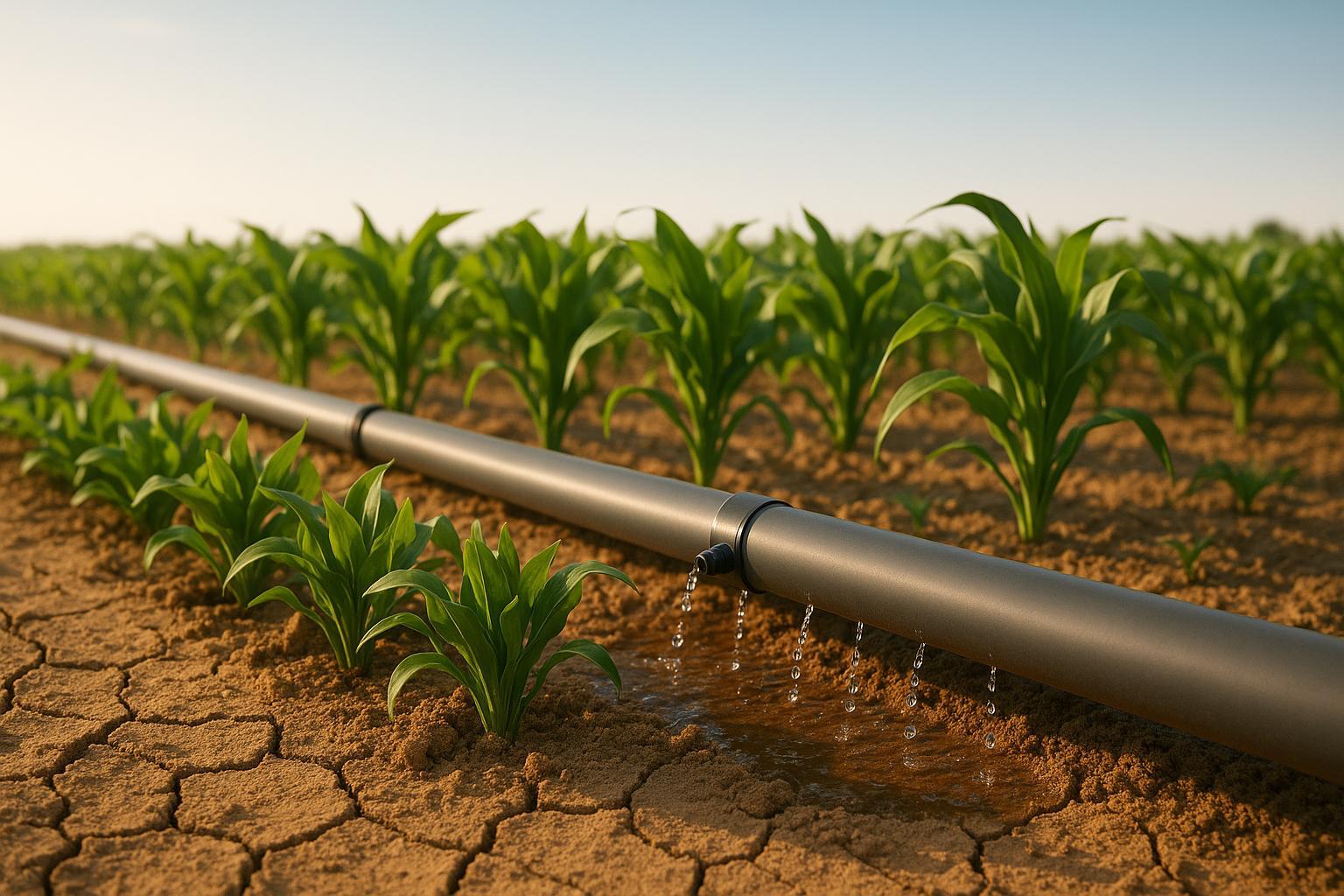
AI Tools for Drought-Resilient Irrigation
Explore how AI tools revolutionize irrigation, helping farmers conserve water and boost crop yields during droughts.
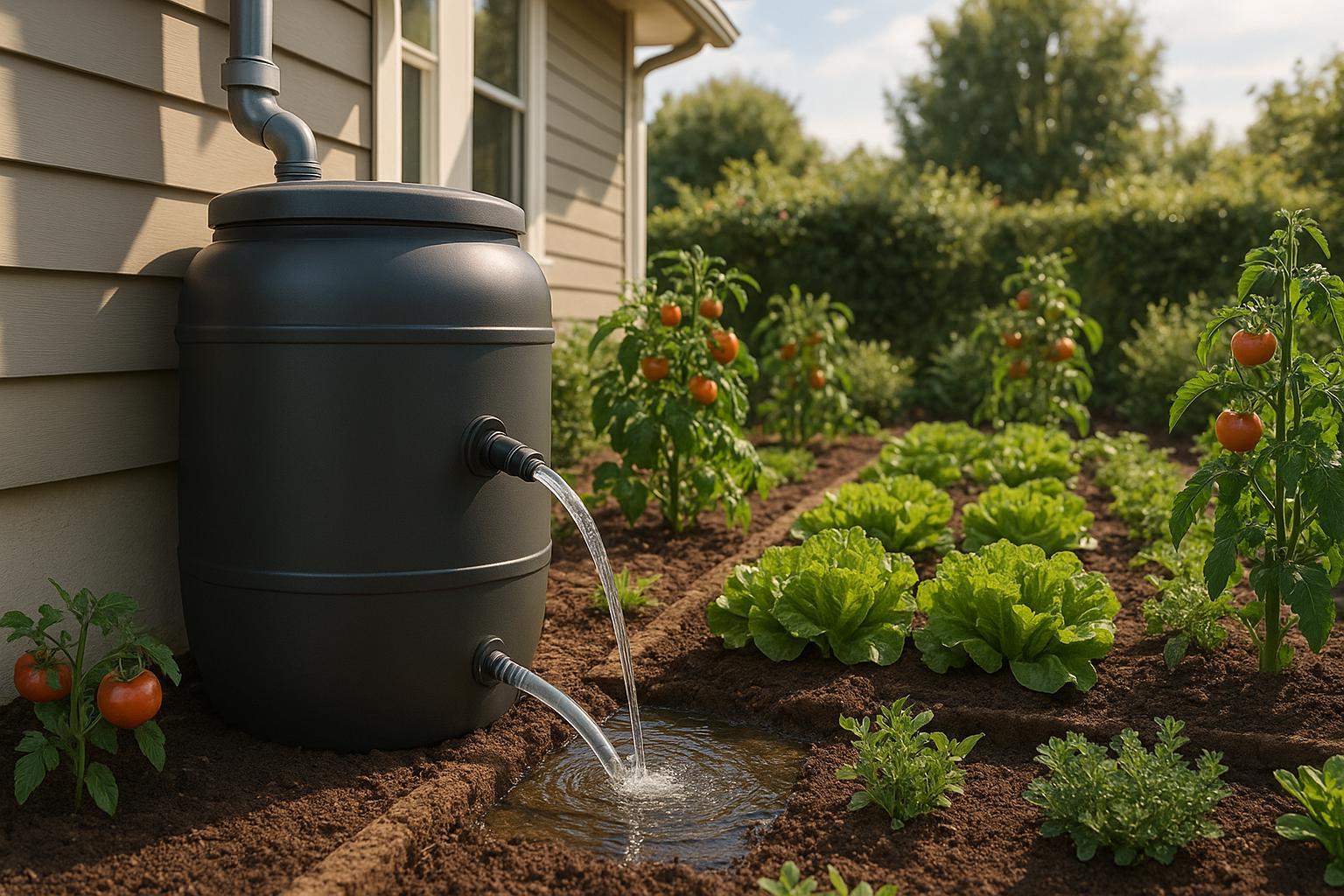
Ultimate Guide to Rainwater Filtration for Gardens
Learn how to implement an effective rainwater filtration system for your garden, enhancing plant growth while conserving water and reducing costs.
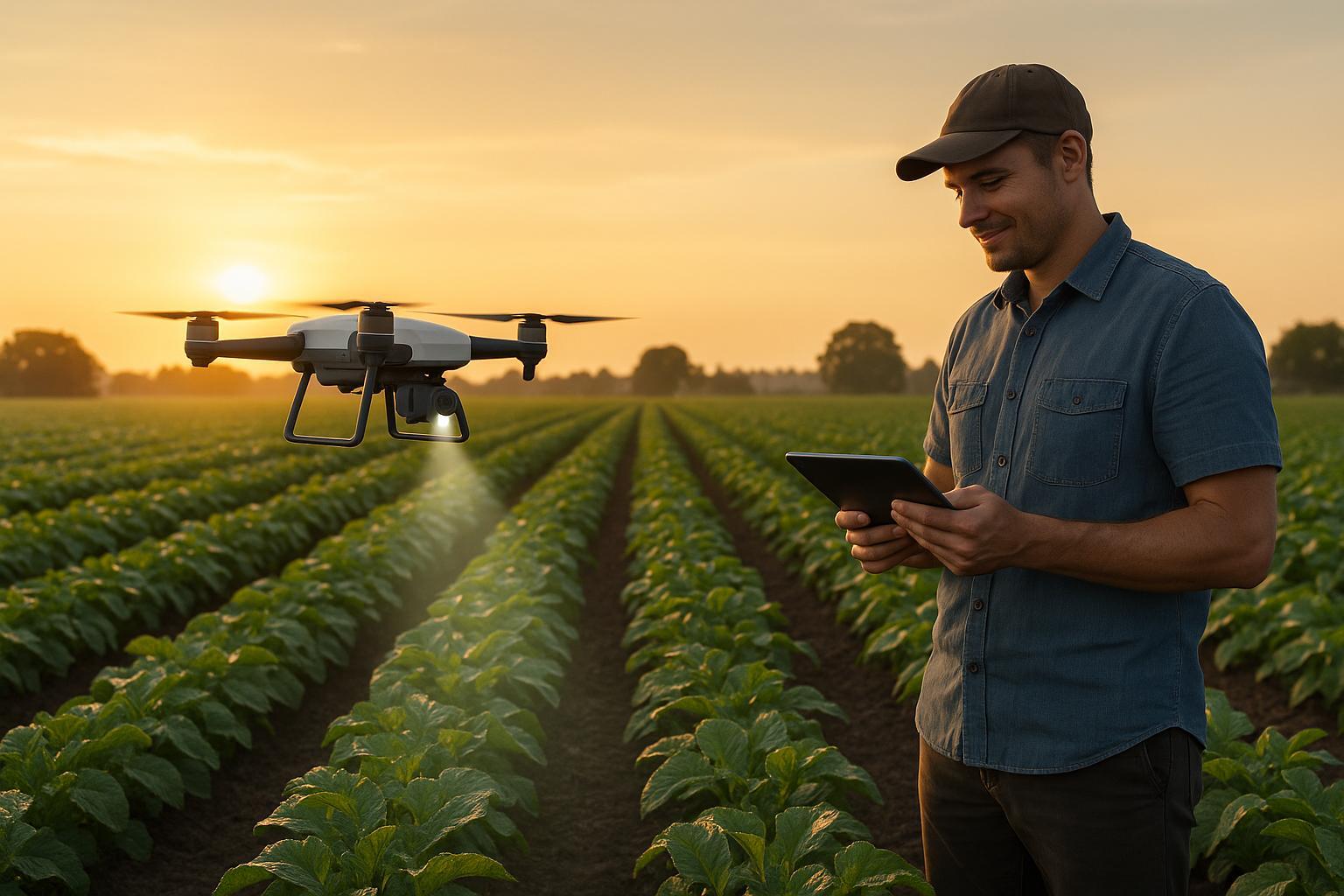
AI Pest Detection vs. Traditional Methods
Explore how AI pest detection outperforms traditional methods, enhancing crop health and sustainability while reducing chemical usage.
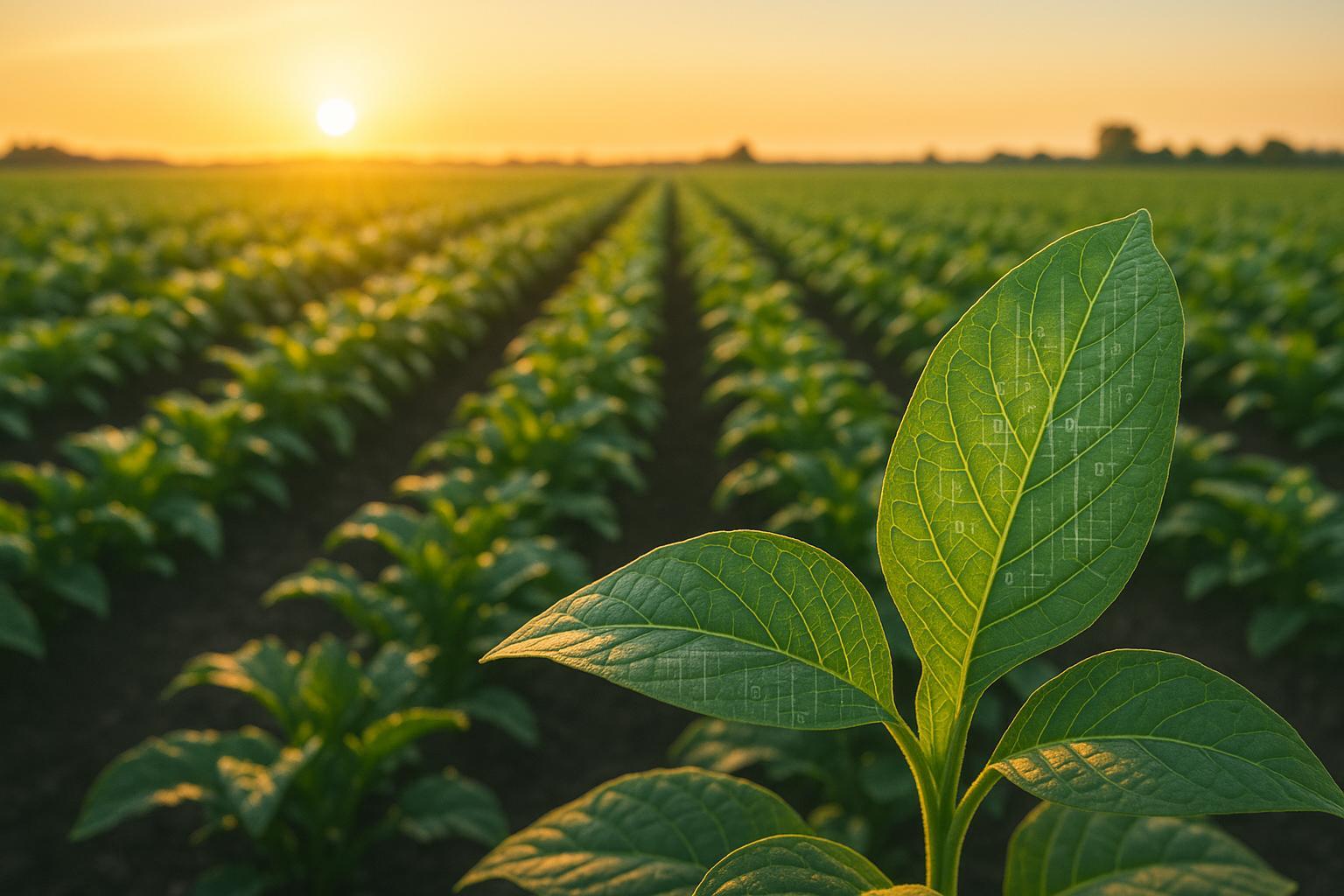
AI in Plant Breeding: Disease Resistance Insights
Explore how AI revolutionizes plant breeding, enhancing disease resistance and accelerating the development of resilient crops.
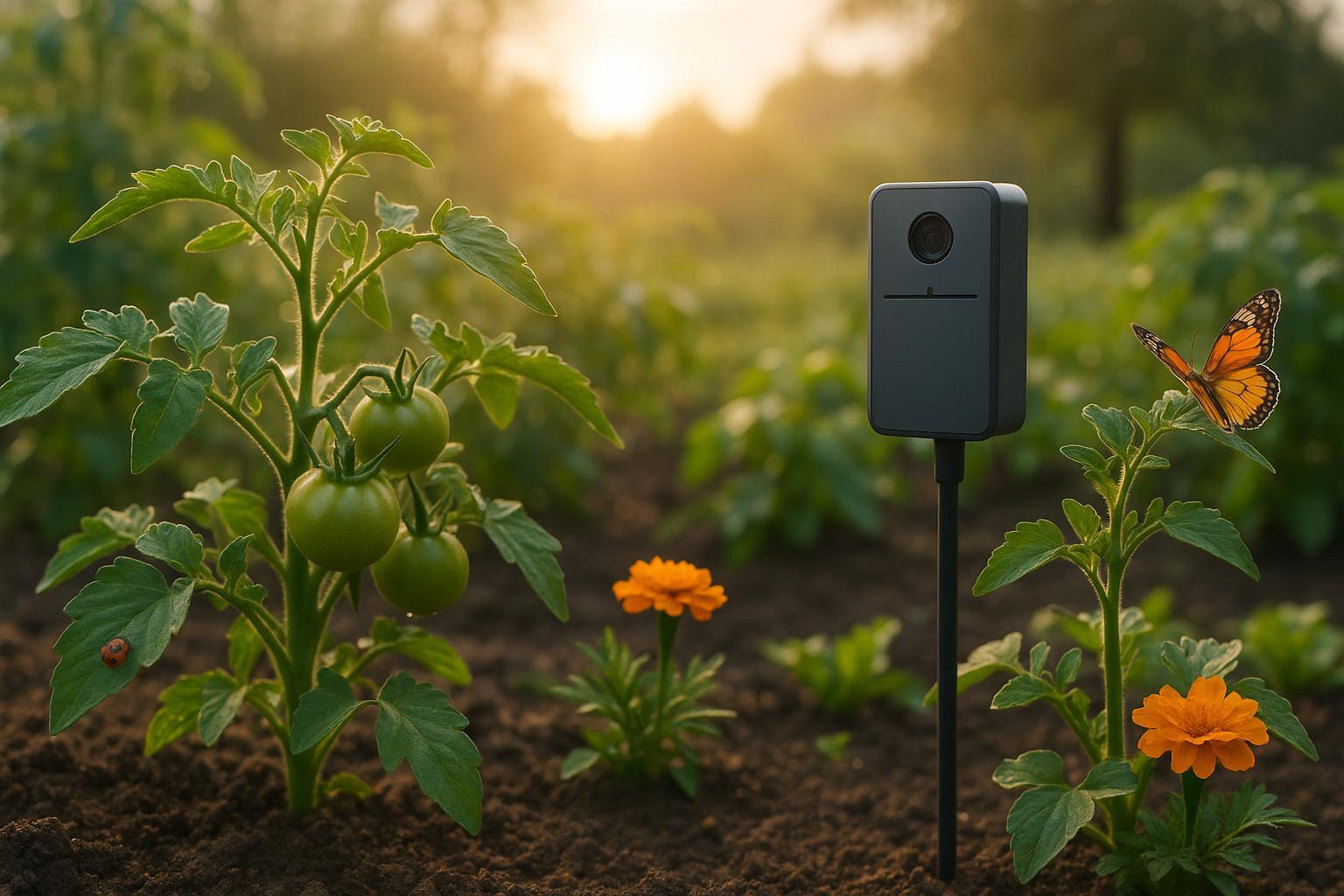
AI Pest Control: How Algorithms Detect Threats
Explore how AI is transforming pest control through early detection, eco-friendly solutions, and accessible tools for all gardeners.
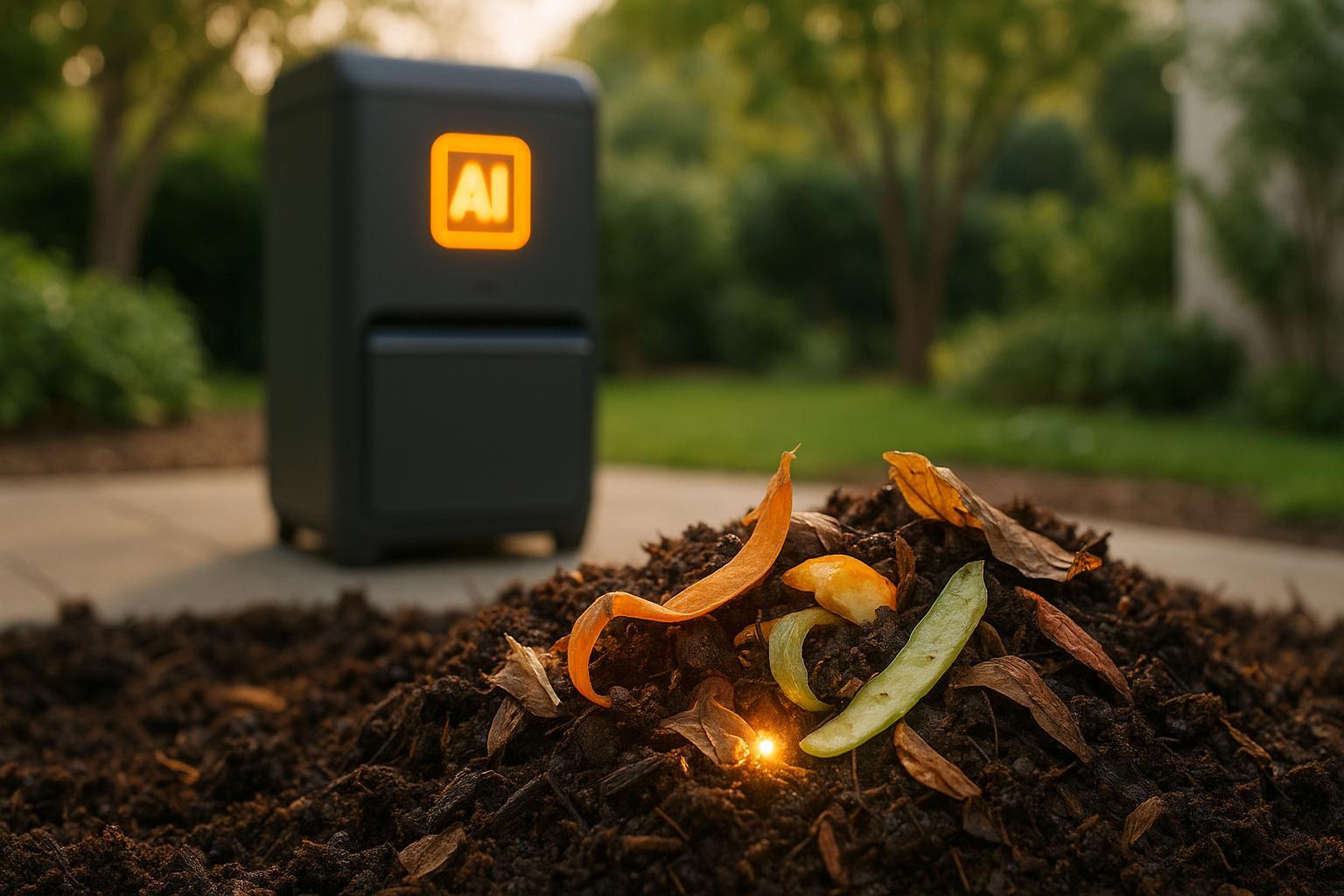
AI Composting: How It Works
Explore how AI composting enhances efficiency, reduces emissions, and transforms organic waste into high-quality compost through advanced technology.